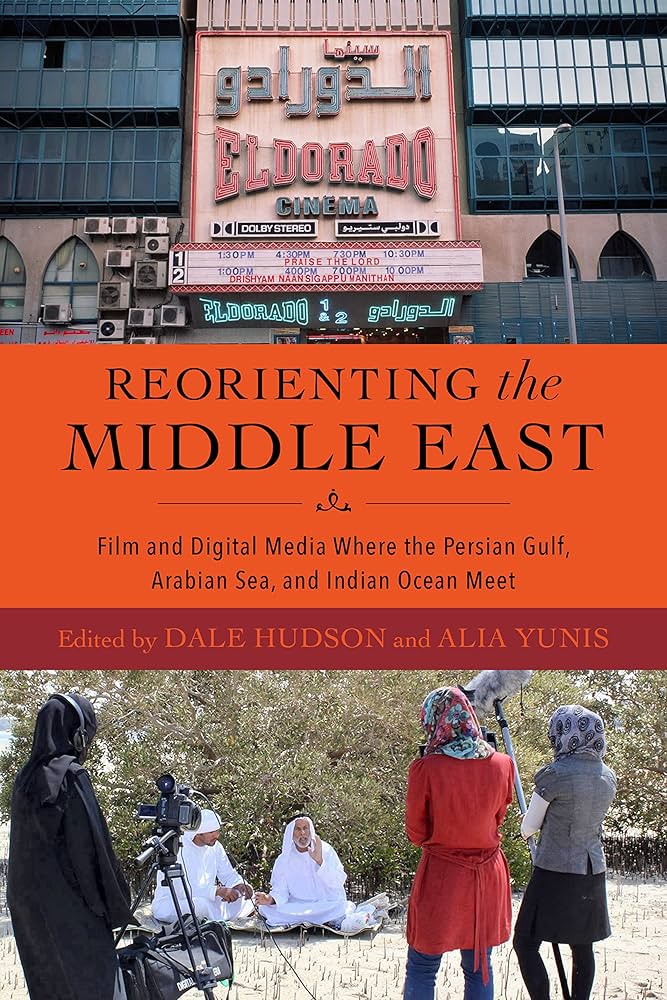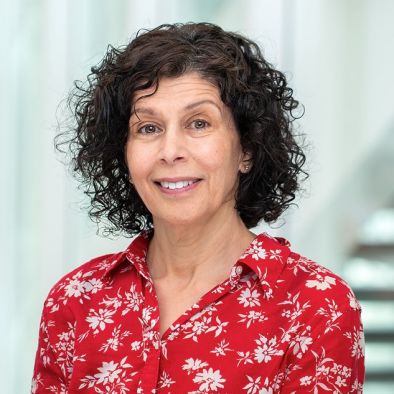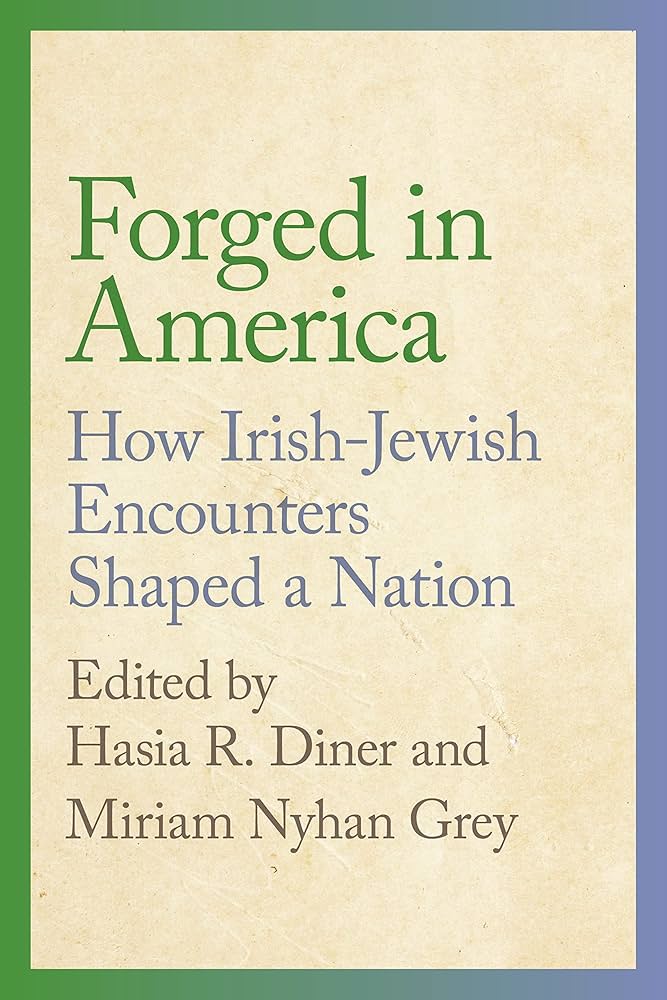Spotlight
Interviews with Authors of New Books on Migration and Mobility 2025-2026
Roland Stinner interviews Dale Hudson and Alia Yunis about their book, Reorienting the Middle East: Film and Digital Media Where the Persian Gulf, Arabian Sea, and Indian Ocean Meet (Indiana University Press, 2024).

About the authors
Dale Hudson is an Associate Professor of Film and New Media and Global Network Associate Professor of Film and New Media at NYU Abu Dhabi, where he also serves as Curator of Film and New Media. His research focuses on postcolonial and transnational film and digital media, art and ecological media practices, and film and visual culture in the Middle East (Southwest Asia), North Africa, and South Asia, with particular attention to the Gulf and Arabian Peninsula. Among his books are Reorienting the Middle East: Film and Digital Media Where the Persian Gulf, Arabian Sea, and Indian Ocean Meet (coedited with Alia Yunis); Vampires, Race, and Transnational Hollywoods; Thinking through Digital Media: Transnational Environments and Locative Places (with Patricia R. Zimmermann); and Documentary Habitats: Transmedia Ecologies (with Patricia R. Zimmermann, forthcoming).

Aliya Yunis is a Visiting Associate Professor of Film and Heritage Studies at NYU Abu Dhabi. Her research and creative work focus on film and television, literature, heritage, memory, and identity in the Middle East and the Gulf, with particular attention to food and the environment. A novelist, filmmaker, and screenwriter, she directed the feature documentary The Golden Harvest (2019), which premiered at the Thessaloniki International Film Festival and won Best of the Fest at the Minneapolis–St. Paul International Film Festival. Her novel The Night Counter (Random House) was widely acclaimed and is taught in universities internationally. Yunis has worked as a screenwriter and script analyst for companies including Village Roadshow Pictures and Miramax, is a PEN Emerging Voices Fellow, and a recipient of a Warner Bros. comedy-writing award. She co-founded the Zayed University Middle East Film Festival, the longest-running film festival in the Gulf.

About the interviewer
Roland Stinner is a student at NYU Abu Dhabi & Tisch.
Roland: First of all, thank you so much for coming today. It was really interesting to read your book. I felt like it really forces us to rethink what we mean by the Middle East—whether the concept even makes sense—and instead to understand it as a crossroads between the Persian Gulf, South Asia, East Africa, and beyond. As the book asks us to shift our focus toward the Gulf as a space of connection, I wanted to start by asking: how did this project begin? What questions were you asking at the start?
Alia: For me, it really came out of my dissertation work, which focused on the UAE. When you live here long enough, you start to notice the silences—the absence of certain stories, including your own community’s stories. You start to ask why these histories aren’t considered interesting or important. A lot of this has to do with national narratives. Borders are relatively new, but they deny histories that go back hundreds of years—histories of movement, trade, war, and marriage involving multiple societies. For me, that history is far more interesting than nationalism.
Dale: Another thing we noticed was how migration was being discussed. About ten years ago, most scholarships focused on South Asian migration, which left out Arab migration entirely—teachers, lawyers, engineers, filmmakers, many of whom were Arab expatriates.
We also saw how official visual histories erase people. For example, early Kuwaiti photography often only shows Kuwaitis and British people. Others are pushed to the margins. That kind of erasure is very typical of nationalist state narratives.
Roland: The title Reorienting the Middle East is really striking. Could you talk about how the title came together and why you chose it?
Dale: We borrowed the term from an exhibition at the Barjeel Art Foundation called Reorient, which looked at how modern Arab art had been excluded from dominant art histories. We liked how the term plays with “orient” and “orientalism,” but also pushes against them.
Originally, we thought of calling the book Reorienting the Gulf, but there were political issues around naming—especially around “Persian Gulf” versus “Arabian Gulf.” We didn’t want to get caught up in that. So we shifted toward the idea of “regions,” even though that’s a term I personally find very uncomfortable. “The region” often implies enclosure and exceptionalism.
Alia: That’s why we focused so much on water. When you open things up to the sea, identities become more fluid. Historically, people moved across water constantly. Languages mixed. Cultures mixed. Littoral spaces were places of encounter, but they’re often left out of national narratives—especially in countries where capitals are far inland.
Roland: What are some of the dominant ideas about the Middle East that your book tries to challenge or rethink?
Alia: When you talk about the Middle East as a single space, it assumes a monolithic people. But coastal Gulf Arabs historically had more in common with South Asia and Iran because of trade routes. Desert Gulf Arabs were more connected to the Mediterranean world through caravan routes. So the word “Arab,” or even “Middle East,” flattens a lot of differences—socially, economically, linguistically.
Dale: Another important layer is Western colonialism and imperialism. The Middle East was created through partitions that forced together groups that didn’t necessarily belong together—similar to how Africa was decolonized. That history matters when we think about contemporary conflicts and movements. That’s why we use multiple lenses in the book—arenas, encounters, relations. No single framework captures everything. You have to move between them.
Roland: Film and media play a major role in the book. Why was it important for you to focus on these, especially beyond professional cinema?
Dale: Film studies is actually a very conservative field. It tends to focus on feature films, capitals, and national cinemas. That leaves out documentaries, short films, and amateur films—which are actually the majority of what gets made. A lot of our research looked at amateur filmmaking, and that’s where migration becomes really visible.
Alia: Short and amateur films open up filmmaking to people who would never have access to traditional film industries—especially working-class people. With platforms like YouTube, people could share stories without going through official channels or censorship. It also changes what we mean by “film.” It doesn’t have to be professionally shot or edited. It just needs a story people care about.
Roland: Migration seems to be one of the strongest threads in the book. How does this help us understand the Gulf differently?
Dale: The Gulf isn’t a place of immigration—it’s a place of migration. People come, make money, and leave. Very few people expect to stay permanently or become citizens. I often think of migration here as waves. One wave comes through, then another replaces it. That’s why older histories get lost.
Alia: And people don’t only come for money. Many come because they can’t live safely at home—Palestinians, Syrians, Lebanese. Others come because the Gulf is a place for people who don’t quite fit elsewhere. It doesn’t give you roots, but it gives you community. That’s something that’s really underestimated, especially in Western perspectives.
Roland: Were there any surprises while working on the book—things you didn’t expect to encounter?
Alia: We already knew a lot going in, but what surprised us were the gaps. For example, we realized no one working on Iran-related media had responded to our initial call, so we had to actively seek that out. We also noticed how little work had been done on Iraqi filmmakers in the UAE, or on non-professional media like audio cassettes exchanged between Kerala and the Gulf. It really showed how rich and understudied this area still is.
Roland: Finally, who do you hope this book reaches, and what do you hope readers take away from it?
Dale: We initially thought it would mainly be for film and media scholars, but it also speaks to area studies, migration studies, anthropology, sociology, and history. A lot of what we’re interested in are stories that never made it into archives—things that exist on YouTube, in family collections, or in memory.
Alia: I also hope readers rethink what counts as a film, and whose voices matter. So many people contributed to media history in this region and were forgotten. We want people to pay attention to what’s been left out of larger narratives.
You can purchase the book here.
Conor McCutcheon interviews Hasia R. Diner about the book Forged in America: How Irish-Jewish Encounters Shaped a Nation (NYU Press, 2024).

About the author
Hasia R. Diner is Professor Emerita at the Departments of History and the Skirball Department of Hebrew and Judaic Studies at New York University, and Director of the Goldstein-Goren Center for American Jewish History. She is the former series editor for our Goldstein-Goren series in American Jewish History. Among her many books are Hungering for America: Italian, Irish and Jewish Foodways in the Age of Migration, The Jews of the United States, 1654 to 2000, We Remember With Reverence and Love: American Jews and the Myth of Silence after the Holocaust, 1945–1962, and Immigration: An American History, with Carl Bon Tempo.

About the interviewer
Conor McCutcheon is a 4th year PhD Student at the NYU Department of Sociology, and is also affiliated with the NYU Shanghai Center for Applied Social and Economic Research. His work concerns the intersection of globalization and inequality, with a focus on the ways in which shifting ideas of nationhood and the increase in interstitial transnational spaces are changing the way that people think and act.
Conor: I want to start with a fundamental premise of the book: your argument that writing the history of ethnic groups in tandem is not something that is done very often and that this neglects a large portion of the actual story. Where did this idea come from for you?
Hasia: In 2017, I was the acting director of Ireland House, otherwise known as the Glucksman Ireland House. The story of Ireland House is that the donors and the founders and the conceivers were a couple: Lewis Glucksman, who was Jewish, and his wife, Loretta Brennan Glucksman, who was Irish-American. She had been kind of lukewarm about being Irish until she met Lou, who loved Ireland. So it was funny. He was the one who kind of reinvigorated, or invigorated her Irish consciousness! And since it was the 25th anniversary, the people here decided that the year's programming would be devoted to the Irish-Jewish encounter in America, like Lou and Loretta. Since I was the director, I was sort of forced into thinking about the subject, and largely the history of the meeting between the Irish and the Jews in America, which has been written as a history of Irish-American antisemitism…but when I started preparing for the talk, what I found was very different; not that it hadnt happen, because it obviously did, but there's another story. And it seemed to me that there are these two stories. They both happened, and the one that I wanted to write, or that I did write, was actually much more formative. Whereas, yes, there were these people in Irish America who were antisemites, but the kinds of interactions and connections that I wanted to write about made a real difference in a way the others did not.
Conor: I'd love to know some in-depth information on how that process emerged, the conceiving of the book and the process of discovering the connections within Irish and Jewish histories.
Hasia:
First, I think most immigration and ethnic histories tend to be done in silos. You're studying “Filipinos in Providence,” and that's what you're doing. You learn every kind of ins and outs and wrinkles and details of the Filipinos in Providence, and you may learn a little bit about their relationship to Filipinos in Boston. I'm making that example up, but it’s Filipinos, Filipinos, Filipinos, which is how American Jewish history is written, and it’s really how Irish American history is written.
And when other, let’s say, outsiders, for lack of a better word, come into the story, they're usually cast as antagonists: “They did bad things to us. They said bad things about us. They didn't want us in their schools. They beat us up,” whatever. But the story of Filipinos in Providence is told as a Filipino-Filipino story, and you have no idea of the more complex and nuanced world in which Filipinos in Providence existed.
I don’t know anything about whether there are even Filipinos in Providence, but I do know about New York Jews and New York Irish. They didn't live in a hermetically sealed world. There were multiple ways, times, and venues in which they bumped up against people from different backgrounds, and it wasn’t all bad. They made their own way economically, intellectually, culturally, educationally, and politically, but these were never done alone. They were done in conjunction with others.
For example, the Jewish story is: “We came here, we went into the public schools, and by God, the children of garment workers became doctors”… blah, blah, blah. And then I said, “But who taught them?” Well, they were Irish-American women who were the teachers. But that’s never told.
Conor: So then, after writing this book, how do you think about these groups in relation to each other? What is the kind of “elevator pitch” description of their relationship that you would use to complement the mainstream narratives of these two ethnic histories?
Hasia:
It would have to be a tall building. But the large-scale Jewish migration to the United States took off at the moment when the Irish, the famine generation, had begun to establish themselves in certain key institutions in American life, despite the incredible prejudice against them as Irish and as Catholic.
So, these Jews, who were primarily coming from the Austro-Hungarian and Czarist Empires starting in the 1870s, arrive in American cities, such as New York, Chicago, Boston, and Providence, and what do they see around them? Here is this group of people, the Irish, and they seem to be controlling everything. They learn enough to know that while the bigger machinery of society is operated and controlled by white Protestants, what the Jews actually see are these guys who have control over things that matter deeply to them: getting their kids into school so they don’t have to be garment workers or sweatshop workers or pushcart peddlers. They've never been in a union; they don’t even know what a labor union is. But these guys run the labor unions, and the Jews could use that too.
And in reverse: in the 1880s, 1890s, and 1900s, the Irish majority in places like New York and Boston is beginning to decline because of mass migration, not just of Jews, but Italians, Poles, Lithuanians, and Ukrainians. The Irish majority is dwindling, and the Irish realize it’s actually in their interest to reach out to some of these folks to keep themselves in power.
So, for example, Mayor Curley in Boston, the longtime Irish political boss, said in an interview I quote in the book, “I’m actually not interested in the Italians at all. I only want the Jews.” And when asked why, he said, “The Italians go back. They don’t vote. Jews vote.”
For Irish labor leaders, they needed as many workers in Cleveland or Chicago organized as possible, so it was in their interest to reach out and help Jewish garment workers learn how to organize. And the same thing with teachers, the more new immigrant kids there are in the schools, the more they can demand.
It’s not that they loved each other, and that’s one of my points. It is not about love. It’s not multiculturalism. It’s about timing, where the Irish have entered this early stage of power and influence just as the Jews are first arriving. And it’s about place, because it’s about American cities, and the whole ethnic constellation at the time.
For example, the Italians hated the Irish because of what went on in the Catholic Church, but Jews couldn't care less what goes on in the Catholic Church. What language confession is going to be given in was of no interest to them. And the same with the Poles in Chicago, the Polish and the Irish hated each other.
So again: it’s about time, it’s about place, it’s about numbers, and it’s not about looking for people to love each other, but to say, “I need you, and you need me, and therefore…"
Conor: Really fascinating. I think this pragmatism speaks to an interesting conundrum in immigration research in general: sometimes similarities matter in terms of bonding and group interaction, but as you point out, sometimes just enough difference is the right amount, right?
Hasia:
Yeah, and in this context, particularly, because they didn’t step on each other’s toes in the religious sphere, which is obviously very hierarchical, and because there were all these ways in which they really had a lot of different things they could give each other.
Conor: Thanks for taking the time to sit down with me.
Hasia: No problem!
You can purchase the book here.